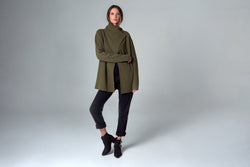Last year we tested a new product range produced with 100% Australian Merino which was nerve-racking. But, it turns out our customers loved it, which was the best news! The opportunity to support local farmers is important to me.
The product range was such a success which means we have added more to the range this season. But I decided that I wanted to know more about our locally-sourced wool and the farm it comes from.
Endeavor Wool Exports is where we source our Merino wool and their business is a three hour drive from Torquay, where I design the Maxted range. I made the trip and got the chance to meet the sheep that produce the wool for our incredible range.
Below is Josh and Peter from Endeavour Wool Exports who took me to Eulong Farm, just outside of Hamilton near Halls Gap, Victoria. It is renowned for producing some of the world's finest Merino wool.
In the centre is Peter, the 6th generation of his family. Since 1901 they've farmed Merino Wool sheep and he currently has 14,000 sheep on 5/6 thousand acres. The scale is huge! I grew up on 1.5 acres with 1 horse and 1 sheep, so the two are incomparable!

Peter kindly brought roughly 500 sheep to the barn for me to view. They were all 2-year-olds and will provide the highest quality wool this year.
Peter explained that the quality is quickly classified during the shearing and the person that classifies the wool is in the centre of 5 shearers. It's an extremely quick process managed by a talented and experienced team. The shearing team are not exclusive to a single farm but travels from farm to farm throughout the shearing season.

Merino Sheep are described as delicate sheep as they grow fine wool. The quality of yarn is graded by colour, length, strength and visual appearance.
Micron is how fine the wool is and each farm grows different microns. The 2-year-old sheep in the barn are expected to mainly be 16/ 17 microns with a few 15 microns. These sheep supply a highly desirable yarn as the lower the micron is the finer the wool and the more money to be made. So, Peter's sheep are some of the finest wool producers available.
The micron chart goes up to 40 microns and that would be for a carpet.

Top line is the supreme quality of fleece. The fleece then gets put into the correct gate where it wait to go into bales.

The pieces and locks (little bits) are from shearing around the face and legs. These come off in separate cut-offs to the main fleece. But nothing goes to waste, every part of the coat is of value.
Here are Peter and I looking at the 'pieces'.

Each bale weighs about 180-200kg and the farmers expect to get between 6-7kg per sheep. It works out to 28 fleeces in a bale.

A Merino wool farm must carefully manage the quality of their rams to ensure that every year the two years olds are able to produce the highest quality grade wool.
The Merino Ram is typically the image we use when we talk about Merino sheep. For example, I've sketched one on our Merino swing tag. So we headed to the fields to meet a few of these guys!

Peter and Toko the sheepdog round them up for us to see.
As you can see it was absolutely stunning to watch, a memorable moment for sure. I would have been happy just looking over the gate, but Peter made me feel welcome so I was able to get closer to the action.

The wool export industry is worth around $3.4 billion to Australia. Before going to the farm I had no idea of the scale of the industry in Australia and believe it's something that we should be really proud of.
Today I'm wearing my Merino Grandpa Cardigan and it feels extra special as I know where the yarn came from.



